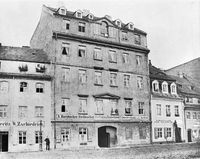Caspar David Friedrich's house
An der Elbe 33
Caspar David Friedrich (Greifswald 1774 – 1840 Dresden), the most important painter of Dresden Romanticism, lived here in the Pirnaische Vorstadt from 1804 until his death. Until its destruction in February 1945, the house at An der Elbe 33 stood at this location. Since 1820, Friedrich lived on the third floor with his wife Caroline Bommer and their three children. The area in front of the old fortress walls must have been pleasant and familiar to him, because he had lived in the immediate neighborhood, in houses no. 27 and 26, for the past 15 years.
He did not choose the place to live right on the river by chance: Friedrich, a Greifswald native and passionate hiker on the Baltic Sea coast, obviously appreciated the immediate proximity to the water. The view from the window of the river became a motif for many of his works. Friedrich traveled regularly to northern Germany, where his family lived, but also to the Bohemian Giant Mountains and the Harz Mountains. There, and on his numerous hikes in the vicinity of Dresden, he created a wealth of detailed nature studies, many of which found their way into his paintings. In his studio, Friedrich created landscape paintings that he composed based on intensive observation of nature. In them, he combined realistic content with a novel pictorial order and a deep, existential feeling.
After the arrival of the Norwegian Johan Christian Clausen Dahl in Dresden in 1818, the shared home of the two landscape painters became a center of artistic exchange in the city from 1823 onwards. Art students, friends, and fellow painters such as Georg Friedrich Kersting, Ernst Ferdinand Oehme, Carl Gustav Carus and Louise Seidler, Karl Blechen, Thomas Fearnley and Raden Saleh, but also personalities such as Johann Wolfgang von Goethe, Friedrich Schleiermacher, and Tsar Nicholas I met here in the first decades of the 19th century.
The Norwegian landscape painter Johan Christian Clausen Dahl (Bergen, Norway 1788 – 1857 Dresden) arrived in Dresden on September 28, 1818. He was on his way from Copenhagen to Rome and Naples, but he decided to settle in the Saxon residence city for two years. From the beginning, he formed a close friendship with the 14 years older Caspar David Friedrich, which lasted until Friedrich‘s death.
After returning from Italy, Dahl and his first wife, Emilie von Block, moved in April 1823 into the house at An der Elbe 33, where Friedrich and his family had been living since the summer of 1820. The close proximity fostered the intensive exchange between the two complementary romantic painters, who were close in their shared artistic vision. However, while Friedrich created complex landscape pictures with symbolic content in a more detailed painting style, Dahl represented a realism that captured the atmospheric with a lively, impasto application of color.
In 1826, Dahl embarked from Dresden on the first of his five extensive trips to Norway, returning with a wealth of nature studies that he developed into realistic landscape paintings of untamed Nordic nature in his Dresden studio. Like Friedrich, Dahl was only appointed professor of landscape painting by the Dresden Art Academy in 1824 after long hesitation. However, this position was not associated with an academic teaching post in either case. Instead, both painters received artists from all over Europe at the house at An der Elbe 33, including many who oriented themselves to the motifs and artistic expressions of Dahl and Friedrich.
After Friedrich‘s death, Dahl dedicated himself to preserving his friend‘s work and sold Friedrich‘ s painting Two Men Contemplating the Moon to the Dresden Gemäldegalerie (Picture Gallery) in 1840. Dahl died on October 14, 1857, and was buried in the nearby Elias Cemetery. In 1934, his remains were reburied in his birthplace at St. Jakob Cemetery in Bergen.
